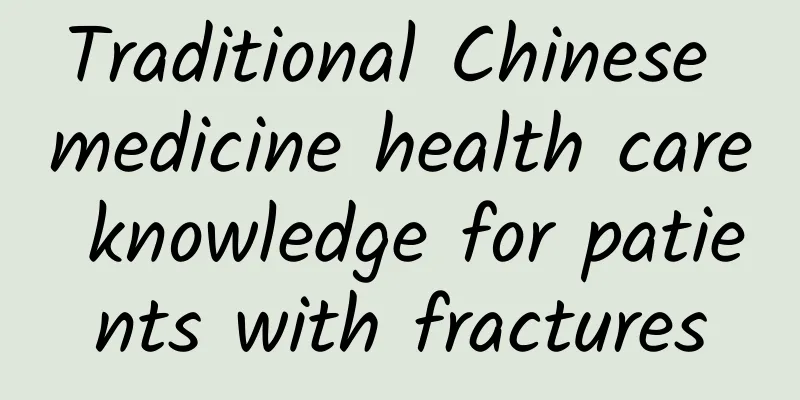Traditional Chinese medicine health care knowledge for patients with fractures

|
Fracture, as a common traumatic disease, not only brings physical pain to patients, but also has a serious impact on their daily life and work. As a traditional medical treasure of the Chinese nation, Chinese medicine plays an important role in the rehabilitation treatment of fractures. Chinese medicine treatment of fractures mainly includes promoting blood circulation and removing blood stasis, repairing tendons and setting bones, and strengthening the body and eliminating evil. In the early stage of fracture, the main focus is on promoting blood circulation and removing blood stasis, promoting the dissipation of blood stasis and reducing swelling and pain; in the middle stage of fracture, attention is paid to repairing tendons and setting bones to promote fracture healing; in the late stage of fracture, emphasis should be placed on strengthening the body and eliminating evil, regulating the body, and preventing the occurrence of complications. This article aims to popularize the knowledge of Chinese medicine health care for fracture patients, and help patients better understand and use Chinese medicine for rehabilitation. 1. Oral administration of Chinese medicine 1. Early stage of fracture The early stage of fracture refers to the period between 1 and 14 days after the injury. It is recommended that the treatment principle be to promote blood circulation and remove blood stasis. To this end, combined with the principle of "three causes and appropriate treatment", light and easily digestible food should be provided, and attention should be paid to eating small meals and balanced food nutrition to meet the patient's dietary needs. At the same time, patients are required to eat less spicy, raw and cold food to avoid damaging the stomach yin and the yang of the spleen and stomach. The dietary prescription recommended is Quyu Shengxin Soup (12 grams of Panax notoginseng slices, 3 dates, 30 grams of Rehmannia glutinosa, and 300 grams of lean pork). Wash the lean pork, remove its fascia and fat thoroughly, put it into a casserole, add 1200 ml of water, boil it over high heat for 15 minutes, then simmer for 60 minutes until the meat is tender, add appropriate amount of chopped green onion and salt, and instruct the patient to take a small bowl of it in the morning and evening to achieve the effects of removing blood stasis, relieving pain, and nourishing yin and promoting body fluid. 2. Middle stage of fracture The middle stage of fracture refers to the period from 21 days after injury to near clinical healing. The recommended treatment principle is bone and tendon setting. To this end, provide patients with a diet that nourishes the liver and kidneys and replenishes qi and blood to achieve the purpose of strengthening tendons and bones. Patients should quit smoking and drinking, and avoid overeating to avoid damage to the spleen and stomach function, which may affect fracture healing. The dietary prescription recommends Drynaria pork bone soup (30 grams each of Salvia miltiorrhiza and Drynaria fortunei, 150 grams of soybeans, 2.1 jin of fresh pork long bones, and appropriate seasonings, such as refined salt, cooking wine, chopped green onions, fragrant powder, MSG, etc.). Wash the Drynaria fortunei and Salvia miltiorrhiza, dry them, cut them into slices, put them into a gauze bag, and tie the bag tightly; wash the soybeans, soak them in warm water for 60 minutes; wash the pork long bones, break them, put them into a casserole, add appropriate amount of water, boil over high heat, skim off the floating residue, add cooking wine, soybeans and their soaking liquid, Salvia miltiorrhiza and Drynaria fortunei medicine bags, cook over medium heat for 40 minutes, take out the medicine bag, add appropriate amount of chopped green onions, cook until the soybeans are well-cooked, add appropriate amount of refined salt, five-spice powder and MSG. 3. Late stage of fracture The late stage of fracture refers to the period when the fracture is close to clinical healing. The treatment principle advocated is to nourish the liver and kidney, strengthen the tendons and bones, and nourish qi and blood. To this end, patients are provided with foods that regulate qi and blood and nourish the liver and kidney. The dietary prescription recommends stewing chicken with angelica, astragalus and wolfberry (1 tender hen, 15 grams of astragalus, 15 grams each of angelica and wolfberry, 3 grams of green onion, 6 slices of ginger, and appropriate amounts of refined salt and rice wine). Kill and clean the hen, put ginger slices, angelica, wolfberry, refined salt, astragalus, green onion, and rice wine into its belly, put it in a pot, and stew it in water for 1 to 2 hours. Instruct the patient to eat the meat and drink the soup once a day. 2. External application of Chinese medicine External application of Chinese medicine is a commonly used TCM treatment method. It can directly act on the fracture site through local medication to achieve the effects of promoting blood circulation, removing blood stasis, reducing swelling and relieving pain. External application of Chinese medicine usually uses Chinese medicine that has the effects of promoting blood circulation, removing blood stasis, reducing swelling and relieving pain, such as frankincense, myrrh, safflower, etc. These drugs can be absorbed through the skin and directly act on the fracture site to promote blood circulation, accelerate the dissipation of blood stasis, and reduce swelling and pain. At the same time, external application of Chinese medicine can also be personalized according to the specific situation of the patient. For example, adding drugs that warm the yang and dispel cold is suitable for patients in cold seasons or with a cold constitution, and adding drugs that clear heat and detoxify is suitable for patients with a higher risk of infection. When using Chinese medicine for external application, you need to pay attention to the following points. First, choose the appropriate Chinese medicine and dosage to avoid overdose or abuse of drugs. Second, pay attention to the time and frequency of external application to avoid using it for too long or too frequently to avoid irritation or damage to the skin. At the same time, keep the external application area clean and hygienic to avoid infection. Finally, when using Chinese medicine for external application, it is also necessary to combine other treatment methods, such as Western medicine fixation, surgery, etc., as well as rehabilitation exercises, diet conditioning, etc., to comprehensively promote the healing and recovery of fractures. 3. Other TCM health care methods 1. Acupuncture therapy: Acupuncture can stimulate the meridians, harmonize qi and blood, and promote fracture healing. Commonly used acupuncture points include Zusanli, Yanglingquan, etc. 2. Massage: Massage can promote local blood circulation, relieve muscle tension and reduce pain. However, it should be noted that massage should be performed under the guidance of a professional doctor to avoid unnecessary damage. Author: Zhou Guohua, Ziyang Traditional Chinese Medicine Hospital, Sichuan Province |
<<: Stop playing with your phone before going to bed, or you might actually go blind...
>>: How does Traditional Chinese Medicine prevent and treat common encephalopathy diseases?
Recommend
What should you pay attention to when driving during the epidemic? Do you need to wear a mask when driving during the epidemic?
Since the epidemic is prone to human-to-human tra...
How long after giving birth can I have liposuction?
A very common worry for mothers after giving birt...
Vulvar itching and fever
Nowadays, due to great social pressure, many wome...
What should I wear in Tibet in summer? How often do pilgrims kneel?
If you travel to Tibet, you must not miss the Pot...
What are the benefits of squatting for women?
In fact, not only men should pay attention to the...
This action is really harmful to the body, but many people do it every day! Solution →
I believe everyone has heard that sitting for a l...
There are large pieces of dandruff after perming my hair
The situation of too much dandruff after perming ...
Postpartum ovarian cysts
Ovarian cysts after childbirth are a relatively c...
Brown discharge a week after period
When menstruation comes, a large amount of bloody...
Can I do moxibustion when I am pregnant?
Moxibustion has certain benefits to the human bod...
What should I do if my episiotomy wound hurts one month after delivery?
If conditions permit, many pregnant mothers will ...
Fake! All fake! Don’t believe these rumors and scams about the epidemic
Along with this round of epidemic, many related r...
[Medical Q&A] My memory always "short-circuits", what's wrong?
Planner: Chinese Medical Association Reviewer: Ti...
Pregnant women with hemorrhoids are more likely to give birth to boys
When it comes to hemorrhoids, many people don'...









